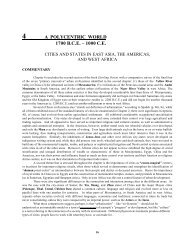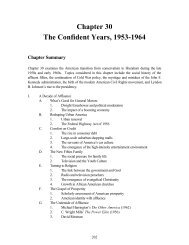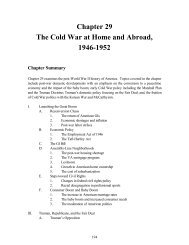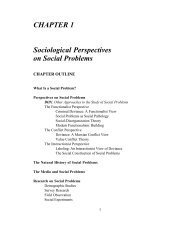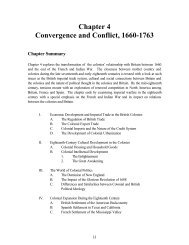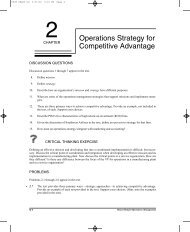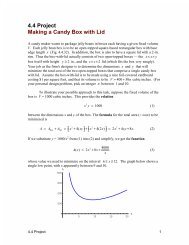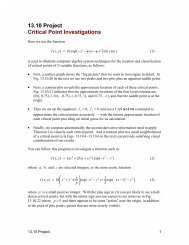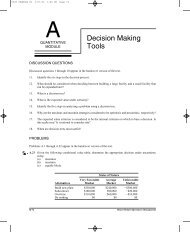Merchandising Operations and the Accounting Cycle - Pearson
Merchandising Operations and the Accounting Cycle - Pearson
Merchandising Operations and the Accounting Cycle - Pearson
You also want an ePaper? Increase the reach of your titles
YUMPU automatically turns print PDFs into web optimized ePapers that Google loves.
Suppose FGL’s Sports Experts stores purchase soccer balls from a manufacturer in<br />
Hong Kong. Sports Experts’ cost of a soccer ball would include<br />
• Cost of <strong>the</strong> ball—say $4.00 per ball.<br />
• Customs duties paid to <strong>the</strong> Canadian government in order to import <strong>the</strong> soccer<br />
balls—say $0.35, added to <strong>the</strong> cost of each ball.<br />
• Shipping cost from <strong>the</strong> manufacturer in Hong Kong to Sports Experts’ location<br />
in Ontario. This cost is called freight or freight in. Assume freight adds $0.50 to<br />
each soccer ball.<br />
• Insurance on <strong>the</strong> soccer balls while in transit—say $0.15 per ball.<br />
In total, Sports Experts’ cost of a soccer ball totals $5.00 ($4.00 + $0.35 + $0.50 +<br />
$0.15). The cost principle applies to all assets, as follows:<br />
The cost of any asset is <strong>the</strong> sum of all <strong>the</strong> costs<br />
incurred to bring <strong>the</strong> asset to its intended use.<br />
For merch<strong>and</strong>ise inventory, <strong>the</strong> intended use is readiness for sale. After <strong>the</strong> goods<br />
are offered for sale, <strong>the</strong>n o<strong>the</strong>r costs, such as advertising, display, <strong>and</strong> sales commissions,<br />
are expensed. Thus <strong>the</strong>se costs are not included as <strong>the</strong> cost of inventory.<br />
The Operating <strong>Cycle</strong> for a<br />
<strong>Merch<strong>and</strong>ising</strong> Business<br />
Some merch<strong>and</strong>ising entities buy inventory, sell <strong>the</strong> inventory to <strong>the</strong>ir customers,<br />
<strong>and</strong> use <strong>the</strong> cash to purchase more inventory to repeat <strong>the</strong> cycle. O<strong>the</strong>r merch<strong>and</strong>isers,<br />
like microbreweries such as Sleeman’s or companies like Magna International<br />
Inc., manufacture <strong>the</strong>ir products <strong>and</strong> sell <strong>the</strong>m to customers. The balance of this<br />
chapter considers <strong>the</strong> first group of merch<strong>and</strong>isers that buy products <strong>and</strong> resell<br />
<strong>the</strong>m. Exhibit 5-2 diagrams <strong>the</strong> operating cycle for cash sales <strong>and</strong> for sales on account.<br />
For a cash sale—Panel A—<strong>the</strong> cycle is from cash to inventory, which is purchased for<br />
resale <strong>and</strong> back to cash. For a sale on account—Panel B—<strong>the</strong> cycle is from cash to inventory<br />
to accounts receivable <strong>and</strong> back to cash. In all lines of business, managers<br />
strive to shorten <strong>the</strong> cycle in order to keep assets active. The faster <strong>the</strong> sale of inventory<br />
<strong>and</strong> <strong>the</strong> collection of cash, <strong>the</strong> higher <strong>the</strong> profits, assuming cost <strong>and</strong> selling price<br />
stay <strong>the</strong> same.<br />
Panel A—Purchase <strong>and</strong> Cash Sale Panel B—Purchase <strong>and</strong> Sale on Account<br />
Cash Sales<br />
Cash<br />
Inventory<br />
Purchases<br />
Collections of Cash<br />
Accounts<br />
Receivable<br />
Cash<br />
Sales on Account<br />
Purchases<br />
Inventory<br />
EXHIBIT 5-2<br />
Operating <strong>Cycle</strong> of a<br />
Merch<strong>and</strong>iser<br />
Chapter Five <strong>Merch<strong>and</strong>ising</strong> <strong>Operations</strong> <strong>and</strong> <strong>the</strong> <strong>Accounting</strong> <strong>Cycle</strong> 225



